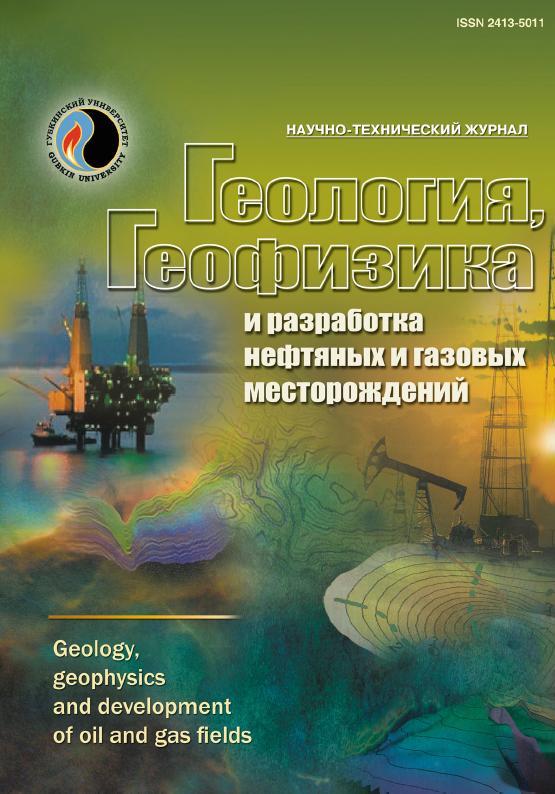Scientific and technical journal
«Geology, geophysics and development of oil and gas fields»
ISSN 2413-5011

Mathematical model for analyzing the development of oil fields with a nonlinear dependence of porosity and permeability on pressure within the frames of water-flooding cells concept
UDC: 622.276.1/.4.001.57
DOI: -
Authors:
1 National University of Oil and Gas “Gubkin University”, Moscow, Russia
2 Eurasian Union of Experts on Subsoil Use, Moscow, Russia
Keywords: water-flooding, elastic deformation, water-flooding cells, dependence of porosity and permeability on pressure, mathematical modeling, development analysis
Annotation:
The authors of the article consider an original mathematical model for analyzing the development of oil fields with a nonlinear dependence of porosity and permeability on pressure within the framework of the concept of waterflooding cells. The model is based on the equations of oil and water volume conservation under surface conditions. With their help reservoir pressure and saturation are calculated, which are used to determine well performance indicators.
The proposed model is tested on a hypothetical example. The model, without taking into account the peculiarities of porosity and permeability changes, is adapted to the results of calculations using a classical hydrodynamic simulator. Then calculations were carried out for porosity nonlinear dependence on pressure and with variable permeability. Calculations have shown that for given conditions the difference in cumulative oil production can range from 20 to 80 % and complexly vary over time.
Thus, accounting for the porosity nonlinear dependence on the pressure and variable permeability can significantly affect the predicted oil production and is important for formations in which such effects occur.
Bibliography:
1. Reservoir development management. – TGL Reservoir Engineering Group, 2010.
2. OFM Well and Reservoir Analysis Software. – Schlumberger. – Data obrashcheniya: 20.03.2024. – URL: http://www.software.slb.com/products/foundation/pages/ofm.aspx
3. Applied use of operational hydrodynamic models in business planning processes and substantiation of geological and technical measures / E.I. Khatmullina, A.T. Khamitov, T.G. Zagurenko [et al.] // SPE Technical Conference "Interaction of Geological and Hydrodynamic Models". – 2013.
4. Acel. БАСПРО. Дата обращения: 20.03.2024. – URL: http://www.baspro.ru/Acel
5. Atlas – Upravlenie zavodneniem. – ZAO "TING". – Data obrashcheniya: 20.03.2024. – URL: https://togi.ru/atlas/
6. Basyrov M. Upravlenie zavodneniem v TNK-VR: effektivnost’ prevyshe vsego // Russian Oil and Gas Technologies Magazine. – 2017. – № 9. – S. 70–76.
7. Afanaskin I.V. Adresnaya otsenka effektivnosti realizuemykh sistem razrabotki neftyanykh mestorozhdeniy // Geologiya, geofizika i razrabotka neftyanykh i gazovykh mestorozhdeniy. – M.: OAO "VNIIOENG", 2016. – № 8. – S. 44–54.
8. Tsifrovoe integrirovannoe modelirovanie v protsesse upravleniya zavodneniem / K.I. Povyshev, R.M. Valiev, M.G. Rechkin, R.D. Khamidullin // PRONEFT’’. Professional’no o nefti. – 2017. – № 4(6). – S. 44–47.
9. Otsenka i klassifikatsiya nevovlekaemykh zapasov po kriteriyu slozhnosti razrabotki (na primere salymskoy gruppy mestorozhdeniy) / M.V. Naugol’nov, S.I. Gabitova, R.I. Murtazin [i dr.] // PRONEFT’’. Professional’no o nefti. – 2020. – № 1(15). – S. 42–46.
10. Bekenov E.M., Yusubaliev R.A., Doskazieva G.Sh. Optimizatsiya sistemy zavodneniya mestorozhdeniya Tyulyus (Respublika Kazakhstan) // Gazovaya promyshlennost’. – 2018. – № 8(772). – S. 42–47.
11. Solyanoy P.V. Optimizatsiya sistem razrabotki zalezhey nefti s neodnorodnym kollektorom slozhnogo stroeniya (na primere yurskikh otlozheniy mestorozhdeniy Kumkol’ i Severnye Buzachi): dis. … kand. tekhn. nauk. – Ufa: UGNTU, 2018. – 150 s.
12. Ankudinov A.A. Sovershenstvovanie metodov analiza sistemy zavodneniya i povysheniya effektivnosti zakachki vody v neftyanoy plast: dis. … kand. tekhn. nauk. – Tyumen’: TIU, 2017. – 114 s.
13. Revisiting reservoir flood-surveillance methods using streamlines / R.P. Batycky, M.R. Thiele, R.O. Baker, Sh.H. Chung // SPE Annual Technical Conference and Exhibition. – 2005. – SPE 95402. – DOI: 10.2523/95402-MS
14. Naugolnov M., Teplyakov, N., Bolshakov M. Cost-Engineering Waterflooding Management Methods // SPE Russian Petroleum Technology. – 2018. – DOI: 10.2118/191580-18rptc-ms
15. Proaktivnyy blochnyy analiz razrabotki mestorozhdeniy / A.N. Sitnikov, A.A. Pustovskikh, A.S. Margarit [i dr.] // PRONEFT’’. Professional’no o nefti. – 2016. – № 1. – S. 60–67.
16. Walsh M.P., Lake L.W. A Generalized Approach to Primary Hydrocarbon Recovery. – Amsterdam, Boston: Elsevier, 2003. – 652 p.
17. Aziz Kh., Settari E. Matematicheskoe modelirovanie plastovykh sistem. – M.–Izhevsk: Institut komp’yuternykh issledovaniy, 2004. – 416 s.
18. Kanevskaya R.D. Matematicheskoe modelirovanie gidrodinamicheskikh protsessov razrabotki mestorozhdeniy uglevodorodov. – M.–Izhevsk: Institut komp’yuternykh issledovaniy, 2002. – 140 s.
19. Basniev K.S., Kochina I.N., Maksimov V.M. Podzemnaya gidrodinamika. – M.: Nedra, 1993. – 416 s.
20. Zheltov Yu.P. Razrabotka neftyanykh mestorozhdeniy. – M.: Nedra, 1986. – 332 s.
21. Spravochnik inzhenera-neftyanika. – T. V(B). Inzhiniring rezervuarov. – M.–Izhevsk: Institut komp’yuternykh issledovaniy, 2018. – 1074 s.